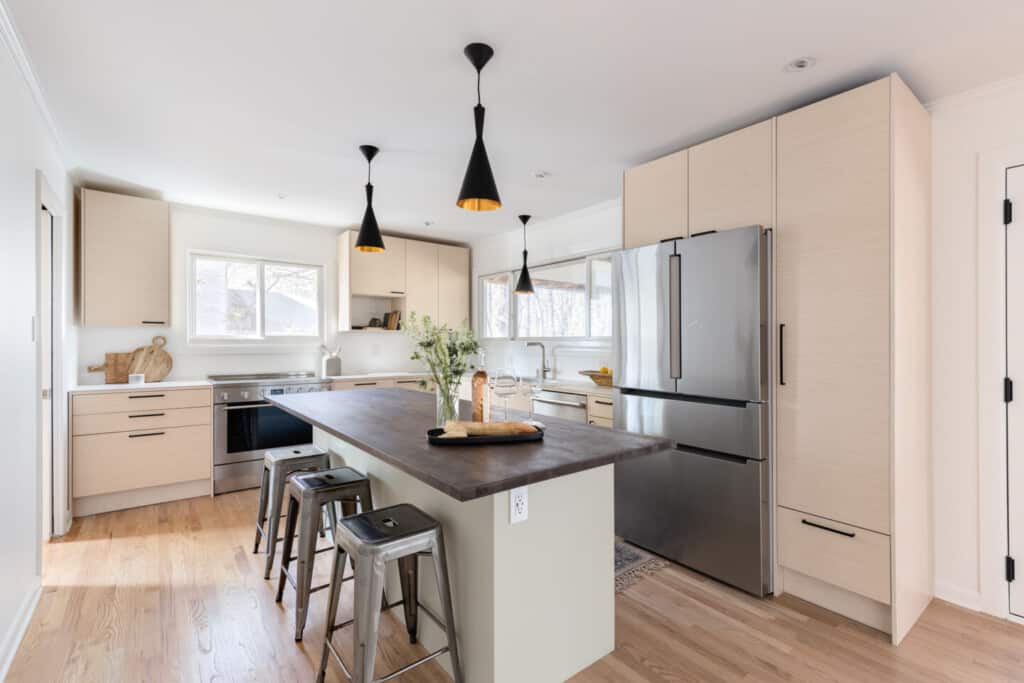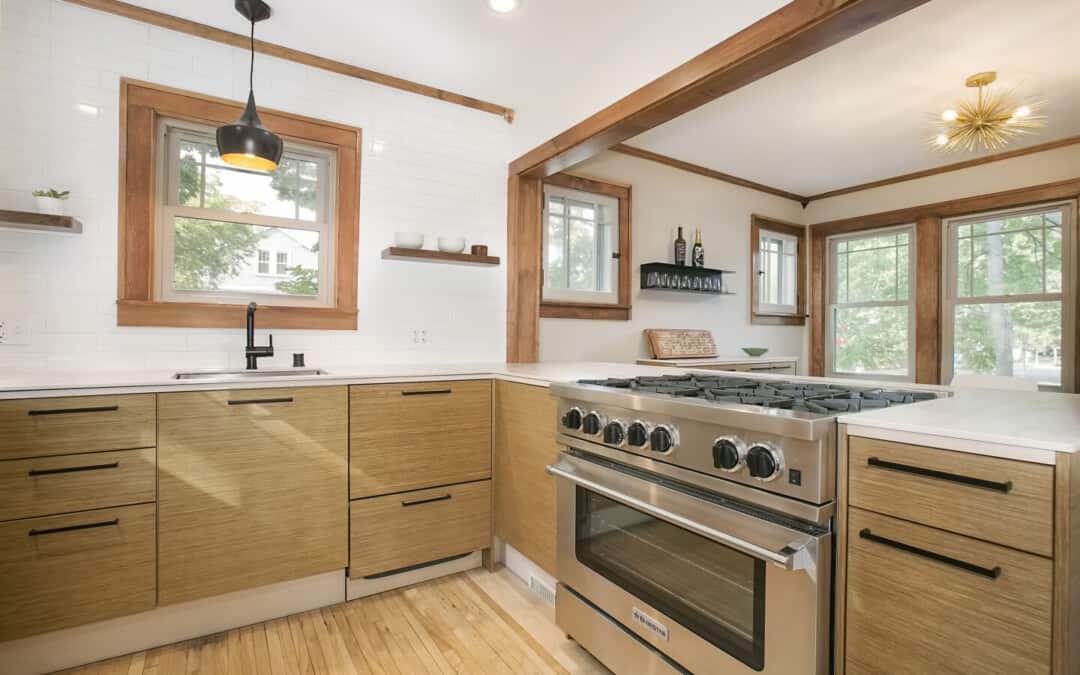Table of Contents
Why Should You Select Low-Formaldehyde Cabinetry, and How Does it Protect Your Health?
If you’re investing in a new kitchen, make sure you ask this question to ensure your cabinets don’t negatively impact your health: “Are these cabinets low in formaldehyde and CARB Phase 2 compliant?”
What does CARB 2 compliant mean?
CARB 2 was established in 2009 by the CARB (California Air Resources Board) as a way to create California emission standards for indoor furniture containing composite wood products known to create indoor formaldehyde off-gassing because of the glue used in wood composite furniture. The CARB Phase 2 emissions standard limits the amount of formaldehyde off-gassing levels allowed from wood composite products. The EPA (Environmental Protection Agency) used the CARB 2 regulations to implement a nationwide formaldehyde emissions law in 2016 called TSCA Title VI.
The wood products affected include:
- Hardwood Plywood
- Particleboard
- Medium-Density Fiberboard
- Thin Medium-Density Fiberboard
This does not include soft plywood, which is often used for exteriors. While you may think there’s not a lot of composite wood in your home, the reality is, composite woods are used to create many products. From kitchen cabinets to doors, flooring, and even toys – composite wood is a common material to come in contact with during daily routine activities.
Formaldehyde is one of the most common VOCs that can be emitted from composite wood products, known as off-gassing. Why such stringent requirements for formaldehyde? As a human carcinogen, this product has been linked to negative health effects, which include:
- Throat irritation
- Skin irritation
- Burning or itchy eyes
- Respiratory difficulties
- Headaches
- Nausea
- Cancer
- Dizziness
- Asthma
If a product is CARB Phase 2 compliant, it meets CARB emission limits and emits lower levels of formaldehyde compared to non-compliant products.
CARB limits include the following:
| Type of Wood | CARB Phase 2 Emission Standard |
| Hardwood plywood | Less than .05 ppm |
| Particleboard | Less than .09 ppm |
| Medium density fiberboard | Less than .11 ppm |
| Thin medium density fiberboard | Less than .13 ppm |
What is CARB and TSCA Title VI?
CARB (California Air Resources Board) is a department for the California Environmental Protection Agency, also known as the ‘Clean Air Agency’. As a regulatory agency, CARB sets air quality standards to protect public health and the environment.
The California Air Resources Board developed a stringent set of formaldehyde emissions rules for composite wood in 2009. In 2016, the EPA worked with the California Air Resources Board (CARB) to create a nationwide rule to reduce formaldehyde emissions from composite wood. As of March 2019, all composite products must be labeled TSCA Title VI compliant, including medium-density fiberboard, hardwood plywood, particleboard, and household and other finished goods that contain these materials.
CARB Phase 2 and TSCA Title VI compliant products produce minimal formaldehyde off-gassing, making them safe for indoor use.
Organizations that care about creating eco-friendly home products, like Puustelli, produce cabinetry that meet or exceed TSCA Title VI standards by not using particleboard, MDF, hardwood plywood and emitting components that contain added formaldehyde or urea-containing formaldehyde.
Who is impacted by CARB Phase 2/TSCA Title VI regulations?
This regulation impacts manufacturers, distributors and retailers of composite wood products who sell products in the United States. Products are now evaluated to make sure they meet the required emissions limits and contribute to improving indoor air quality and reduced formaldehyde emissions and exposure.
Industry leading manufacturers who care about creating sustainable and ecological products, like Puustelli, adopted these practices long before they were regulated, because it’s the right thing to do – even when not enforced.
How can I confirm my cabinets are CARB Phase 2/TSCA Title VI compliant?
All wood products containing composite wood materials made or sold in the United States legally has to be CARB 2/TSCA Title VI compliant. If you’re unable to locate a label or certification, you can always ask the manufacturer or dealer for more information. The labels to look for include “California 93120 Compliant for Formaldehyde”, “California Phase 2 Compliant”, CARB ATCM Phase II or TSCA Title VI compliant.
What if I’m purchasing kitchen cabinets from Europe?
All kitchen cabinets imported from Europe that contain composite wood products must be CARB Phase 2/TSCA Title IV compliant. Europe has its own set of emission standards, and many countries like France, Finland and Germany also have their own set of standards.
E-1 is the formaldehyde safety standard in Europe, which permits formaldehyde emissions for medium density fiberboard of 0.10 ppm. New and more strict formaldehyde emission standards are expected to take effect in 2023 with a three year transition period to lower the allowed amount of formaldehyde in wood products to 0.05ppm.
The French use a rating system of A+ to C, with A+ being the gold standard. The formaldehyde standard to obtain an A+ ranking is < 10 μg/m3.
In Finland, low-emissions materials and furniture are ranked by the M1-certified building material classification. M1 classification is based on stringent independent, third-party laboratory testing and measures the chemical emissions and odors emitted by indoor furniture materials such as formaldehyde and ammonia. We’re proud to share that Puustelli Miinus cabinetry products hold a top M1 indoor air rating (the rating system used in Finland).
How do CARB Phase 2 Compliant, UL Greenguard, and Puustelli’s M1 formaldehyde emissions levels compare?
The most common certifications you’ll find in the United States are CARB/TSCA Title IV and UL GREENGUARD certified. Unlike CARB 2 regulations, UL GREENGUARD certification was originally used by the EPA and the state of Washington to control emissions limits of furniture purchased for “furniture and commercial building products“. UL GREENGUARD certifications also include UL GREENGUARD GOLD certifications with more strict VOC emissions standards to distinguish furniture appropriate for use in healthcare and school settings.
UL Greenguard certification differs from CARB 2/TSCA Title VI because UL Greenguard certified and UL Greenguard Gold Certified includes limits on 360 VOCs, and the total emissions combined rather than just formaldehyde off-gassing. UL Greenguard certification’s total VOC limit is 500 mg/m3 (220 mg/m3 for Gold), and .05ppm for formaldehyde (.0073ppm for Gold).
Here, you can see the variation in emission standards between TSCA Title VI, CARB Phase 2, and M1, which is the classification Puustelli currently holds.
|
Certification |
Formaldehyde level/certification standard |
|
M1 Rating |
≤0.05mg/m 2h |
|
European Union E1 Standard |
≤0.1ppm (soon to become ≤0.05ppm) |
|
CARB 2 Hardwood Plywood |
≤0.05ppm |
|
CARB 2 Particleboard |
≤0.09ppm |
|
CARB 2 MDF (medium density fiberboard) |
≤0.11ppm |
|
CARB 2 Thin MDF |
≤0.13ppm |
|
UL GREENGUARD |
≤0.05ppm |
|
UL GREENGUARD GOLD |
≤0.0073ppm |
I’m interested in Puustelli products, are they CARB Phase 2/TSCA Title VI compliant?
At Puustelli, we know that clean indoor air at home plays a major role in our health and wellbeing (hence why we’re such fans of biophilic design). In 2013, we created a revolutionary cabinetry line where toxic materials have been removed and replaced by 100% recyclable and reusable biocomposite components. Our Miinus cabinetry naturally adhere to CARB Phase 2 regulations because they are made from real wood and biocomposite materials without the presence of toxic glues, solvents, particleboard, hardwood plywood and medium density fiberboard.
Creating a timeless design in your kitchen, at Puustelli, always includes your health and safety. If you’re ready to talk to an expert about designing a kitchen that will not emit dangerous levels of formaldehyde in your home, we invite you to reach out. We’d love to learn more about your project and get you started on your home remodel project.
What are Volatile Organic Compounds?
VOCs are chemical compounds that evaporate and release gas into the air. These gasses can be emitted from many household products and materials like cabinets, paint, cleaning products, carpet, and furniture. If you’ve ever walked into a house and noticed a “new home” smell you’ve probably been smelling VOCs. VOCs have long-term and short-term health effects. This can include anything from throat irritation to cancer. While there is no way to completely eliminate VOC exposure, there are ways to reduce the amount of VOCs in your home. The best option is to invest in low-VOC or no-VOC products, like CARB Phase 2 compliant kitchen cabinets, which can reduce off-gassing. You can also invest in good ventilation – but that doesn’t stop products from potentially contaminating the air you breathe with airborne toxins.

What are airborne toxic emissions?
“Airborne toxic emissions” is an umbrella term for harmful substances released into the air. VOCs, PM, NOx, SO2, CO, heavy metals, and POPs are all airborne toxic emissions that can have a negative effect on human health, and the environment.
When left unregulated and unmitigated, these emissions contribute to indoor and outdoor air pollution and can lead to health concerns. At its worst, airborne toxic emissions can negatively impact our entire ecosystem.
Public and private sector organizations have recently begun to test and regulate emissions through control technologies, innovations and policies. In 2018, CARB Phase 2/TSCA Title VI compliance became one of the most recent additions to airborne toxic emission regulations and went into effect in 2019.
Which types of kitchen cabinets are most at risk for higher VOC levels?
Composite woods, also known as engineered wood or composite lumber, are made by combining wood fibers with a binding agent and other additives to create a composite material. VOCs can be found in the glue used to hold composite wood items together. So, composite woods have a higher likelihood of higher VOC – that is, if they aren’t made with low- or no-VOC adhesives.
Solid wood cabinets that are made with FSC certified wood, or a material like aluminum, are most likely to have low VOC levels, as there is less glue needed to hold the cabinets together. While this may make sense for cabinet doors, avoiding composite wood all together in your kitchen cabinets can be hard. Composite wood was created to increase durability, minimize moisture damage, and reduce the chances of rot. Even if you invest in solid wood cabinets, composite wood is frequently used in cabinet bases. This is why Puustelli Miinus cabinetry is the top choice for low-VOC cabinetry. Puustelli Miinus cabinet bases are made of incredibly strong biocomposite instead of composite wood, meaning they contain 0% formaldehyde. Biocompsite also does not attract dust, and is 100% reusable and recyclable.
Before making a purchase, look for reputable labels and certifications to ensure your kitchen cabinets contain little to no formaldehyde.

What is formaldehyde?
Formaldehyde is a gas that comes from plants and animals. Formaldehyde will never be completely avoided, as it is naturally occurring. Human industries can also create and produce formaldehyde. Manufacturing facilities, power plants, and transportation exhaust have all been found to increase formaldehyde exposure.
The EPA created TSCA Title VI compliance to ensure formaldehyde isn’t omitted at harmful levels inside our homes. One of the best non-toxic cabinet materials—not to mention the most beautiful and timeless—is natural solid wood. Consider the toxicity of stains and finishes when selecting cabinetry, and look for natural wood options that are finished with natural oils or water-soluble stains and varnishes. Some common types of natural wood cabinets include:
- Oak
- Pine
- Maple
- Hickory
- Birch
Where You Can Find Non-Toxic Cabinets
Non-toxic cabinets are a great option for both remodels and new builds. At Puustelli, we’ve applied more than 100 years of Scandinavian kitchen cabinetry know-how to develop non-toxic kitchen cabinets with a top indoor air rating that help you feel more at ease in your new kitchen.
Puustelli Miinus cabinets are made without MDF, particleboard and chipboard, and they contain no formaldehyde, toxic solvents or stains.
Our non-toxic cabinets are also completely customizable, so you can have the look and feel of the kitchen of your dreams. With Puustelli cabinets, you can feel confident taking another step towards keeping your family and the environment healthy.
Ready to learn more about Puustelli cabinetry? Contact our team to learn more about our non-toxic cabinets and set up a free consultation at our Edina, Minnesota showroom location.

